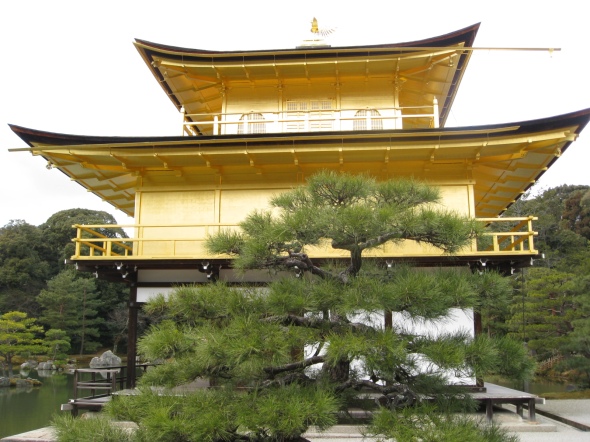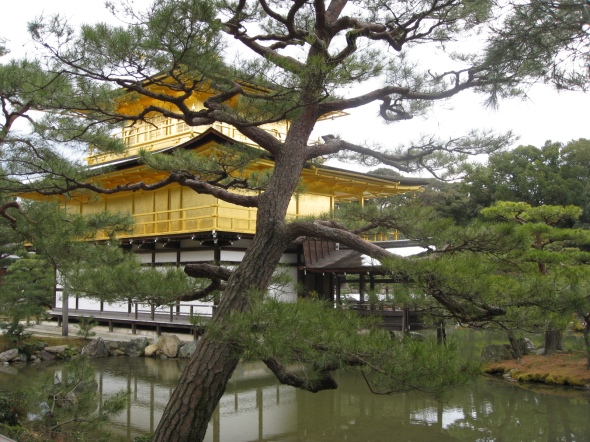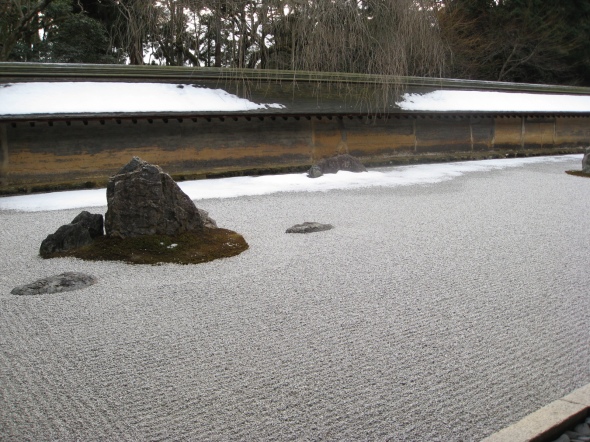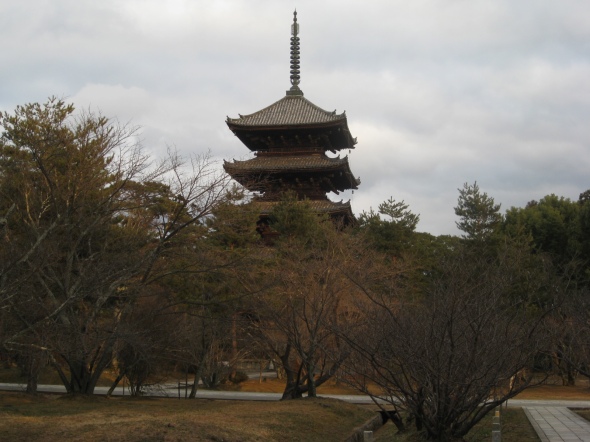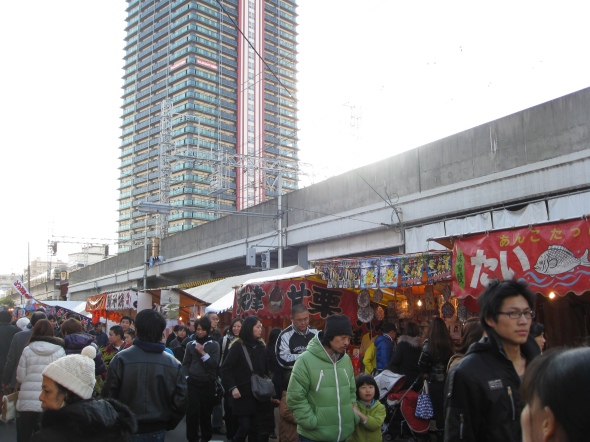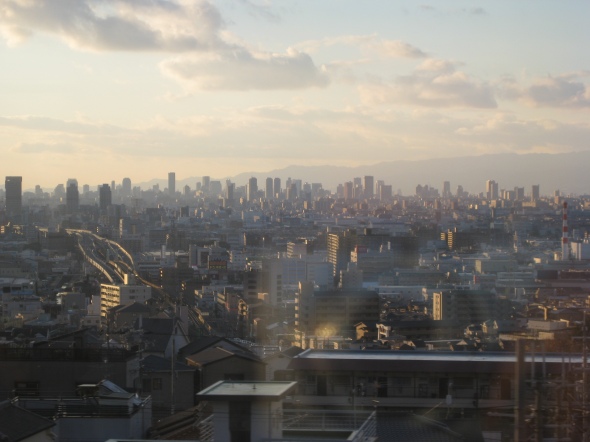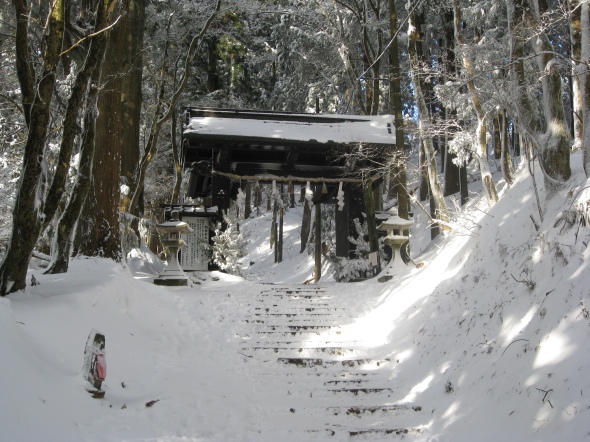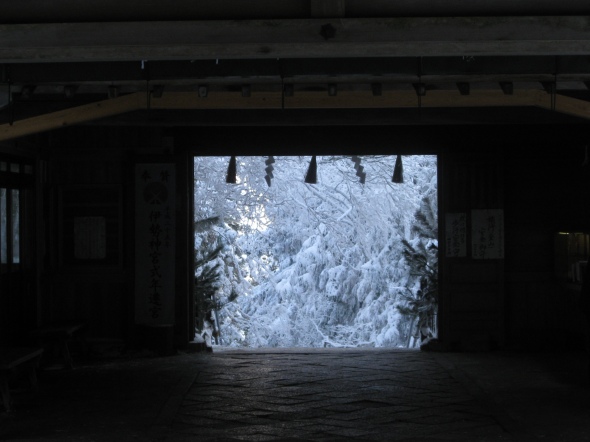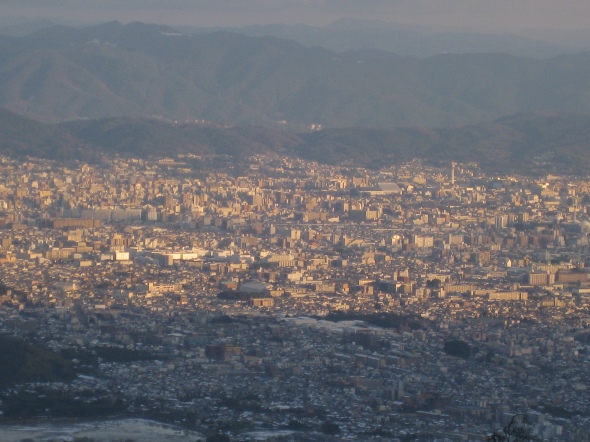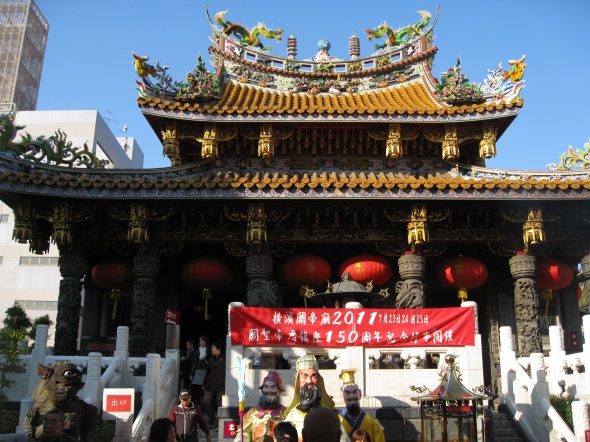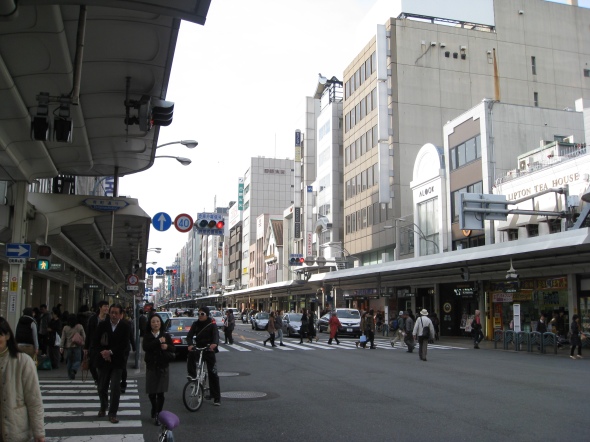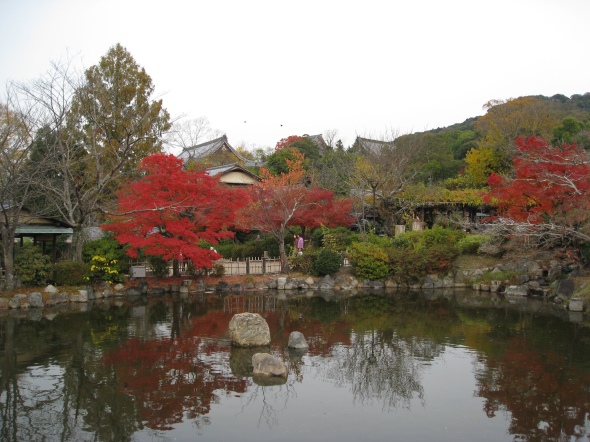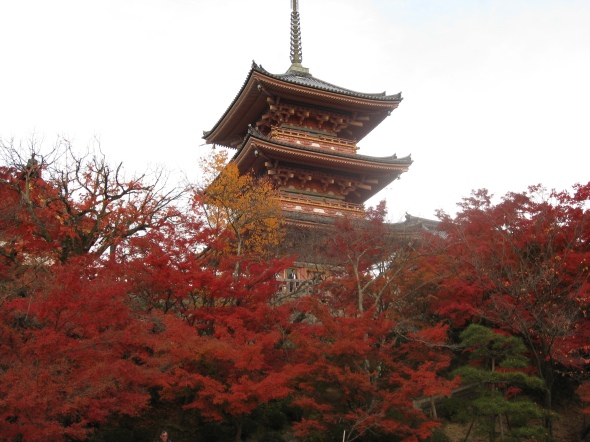Kyoto Temple Crawl
I lived in Kyoto once for eight months, and yet there is still so much I haven’t seen. Recently I’ve worked to remedy some of that.
On the northern edge of the city, up against the mountains, is an area of great national and historical significance. Despite its fame, it is still a rather quiet neighborhood with limited train access, which might explain why my younger self never got to it. I got up early on a day off, though, took the bus up, and there I was for a good old Buddhist temple crawl.
I began with Kinkakuji, a temple built at the turn of the 15th century by great shogun Ashikaga Yoshimitsu as his retirement villa. In an earlier post, I explored Ginkakuji, built by his grandson in similar fashion. This one, though, is far more famous for being covered in gold. Real gold! On an ordinary day, this area is so packed with tourists it’s impossible to move freely through the site.
Good thing my day off of work is Wednesday, so I could see the temple in peace, and take pictures that make it look like nobody’s there.
I didn’t think I’d be impressed, but I could honestly not believe that building was real. The 15th-century original might have survived, but it was burned down in 1950 by one of the monks who lived there. Why he did it is a great mystery he took to the grave, but standing there perhaps I could see why. It was too much for this earth.
I sat down at a temple teahouse for some maccha, and hit the road east to Ryoanji, a temple from the late 15th century. Ryoanji is famous, especially in Japanese art history studies, not for its architecture, but for possessing the archetypal Zen garden. I, though, had no clue what to expect.

And there it was, the Zen garden said to have inspired them all, the great of greats. I was surprised at its emptiness- but then again, this was Zen. I spent so long there, looking not only at the garden, but the roughness of the walls and how the snow lay.
I find that even if something gets lost in a photograph, I can usually capture something of what I saw when I was in a particular place. Sometimes the picture even looks better than the moment itself.
As soon as I took these pictures, I was shocked to realize they conveyed nothing of what I could see. It was almost literally not the same garden. Either the breadth and suggestive power of peripheral vision, or the depth of stereoscopic vision, or the rapid glance of an eye’s movement, was missing. These pictures may look interesting now, but had you been there they would have seemed pathetic. Ryoanji was designed so that only living human eyes could look upon it.
Humbled, I left for Ninnaji.
The other two temples I had seen were young compared to Ninnaji, founded in the 9th century, the early days of Kyoto. The temple was destroyed by the Onin War in the 1460s, and finally rebuilt in the 17th century after the lands had been unified. Ninnaji formerly served as the interim imperial palace, so the site is divided into two sections, the palace and temple.

A plum grove in winter. The trees in bloom appeal to the Heian mind, but the bare trees appeal to the Zen mind.
Now the temples were closing, and my legs were tired. I know but enough, as they say at Ryoanji. I headed back south for some hot food.
Holy Days 4- Surprise Party
Roll back your memories to a month ago, kind reader.
In the second week of the new year, after the holiday season had ended and I was settling into daily life, I emerged one day from my apartment to discover quite a crowd outside.
Turned out it was a three-day holiday for Ebisu, god of things like good fortune, business, profit, and fishing. The alley was lined with stall after stall of old-timey carnival games and food- everything from Indian curry, to ramen hamburgers, to roast pig offal (it’s an Osaka thing…)

The procession lead to Imamiya Ebisu Shrine, where people came to discard last year's relics and buy new ones.
Holy Days 3- Capital of Good Fortune
I rounded things out during my New Year’s by visiting Nara, a city I had only seen briefly during my student days, and with a dead camera to boot.
In a landscape of historical cities, Nara is one of the most ancient, founded in the year 704 as the capital of what grew into Japan, before Kyoto was anything more than a few farms and the odd mountainside shrine. It lies on the other side of the mountain ridge that defines the eastern edge of Osaka, in a land once known as Yamato- a name that has almost become synonymous for Japan itself. Nara faded into obscurity after the imperial house moved to Kyoto in 794, but grew back up into a modest but significant city in the 1600s as Japan urbanized under the Tokugawa rule. Now it finds itself with some 360,000 or so people, a small city but one with a reputation beyond its size.
The last great destruction to visit Nara occurred during the medieval struggles of warlords, so Nara is a city of history and artifacts. The whole east side of downtown has become something of a vast holy park, where ancient temples and shrines abut each other amidst greenery, and deer freely roam in public. How they keep them from disrupting traffic, I don’t know. Considering how much is here, I decided to choose places I hadn’t seen before.

Kofukuji, a Buddhist temple dating back to the early days of the city. The current buildings come from the 14th-15th centuries. The tower might have been the tallest building in Japan at one time.

In Japan, the past is always being rediscovered. The main hall of Kofukuji was destroyed centuries ago, and only recently has been definitively uncovered. Now they are trying to rebuild it to 8th-century standards. They expect to be done in another decade.

The road through the old-growth woods to Kasuga Shrine, former family shrine of the Fujiwara, ancient regents to the emperor.

People come to shrines on the first days of the new year to pray, burn last year's talismans, obtain new ones, and get their fortune. I had no old charms to dispose of, but I returned with a demon-slaying arrow and a fortune good enough to keep as a talisman.

Gangoji, once a powerful institution in Nara, now something of a neighborhood temple. The hall dates to the 1100s.
But I didn’t just come for ancient temples. I have an interest in cities, and wanted to see just a little of the place that had grown up around these old precincts. I was especially interested in Nara because I think of it as a counterpart to Wakayama, which I had visited earlier. They both have around the same population, and are both well-known regional cities in rural, mountainous areas neighboring Osaka.
Wakayama, as I mentioned in an older post, is a city with a strange feeling of emptiness. The streets are massively broad, the spaces between the buildings are wider than most Japanese cities, and in a city with only 360,000 people it made me feel as if the city had been built for a much larger populace than can fill all the space.
Nara is a much different place. Downtown is a little more “traditional” Japanese in that the streets are narrow and the buildings smaller but densely packed. Nara has enjoyed an upswing in status over the past century, while Wakayama has steadily declined from its former place as one of Japan’s greatest cities. These factors combined made Nara feel like a far more lively…and urban city. I’m starting to judge a city by how much I could enjoy moving there, and living in Nara wouldn’t be bad. Small, but busy enough and full of history and nature.
Speaking of cities…
The Japanese don’t really have the notion of a skyline the way we Americans do. Their big cities are all surrounded by other dense cities, so there’s no moment of open highway where one gets to see the whole city from a distance, a la Chicago or New York. Besides, their skyscrapers have never been quite as big, possibly because of the threat of earthquake.
And yet, as the train to Nara ascended into the mountains on the edge of Osaka Prefecture, I caught a rare glimpse. Yes, the skyline of Osaka, captured.
Holy Days 2- Snowbound
The next day, I headed to Kyoto, which had experienced decent snowfall on the night of the new year. On my way in, I could see vestiges of snow in the shade- a rarity in this area of Japan. I was back in my old neighborhood to visit a shrine.
I had climbed Atago before, early in my student days, but found the shrine was undergoing repairs. Something of an anticlimax. I would be seeing it now for the first time, then. Atago Shrine dates back to the 8th century, and various ancient gods are enshrined there. Among them is Izanami, arch-mother of all the Japanese gods, often overlooked in worship the same way Uranus was the progenitor of all Greek gods but was often forgotten. Before the Meiji government started controlling religion in Japan, the shrine was also a Buddhist temple. So a rather syncretic site.
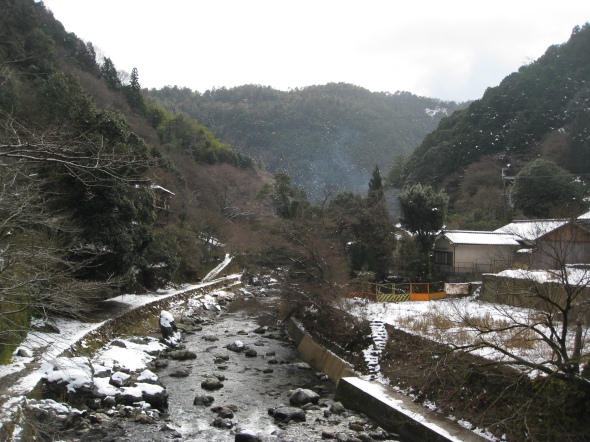
I had to take a bus north, through a mountain pass, to the village of Kiyotaki. Technically still the city of Kyoto, oddly enough.
I was not alone in climbing. The path up to Atago Shrine was full of visitors for the new year- youth, elderly, families with infants. At some point in the 20th century, there was a cable car that ran up the mountain. The foundations and clearings of little shops and teahouses that used to serve its passengers could be seen along the path here and there.
Lower on the mountainside, the trail was muddy and full of the dripping sounds of snowmelt, but three quarters of the way up, the shift in temperature was palpable.
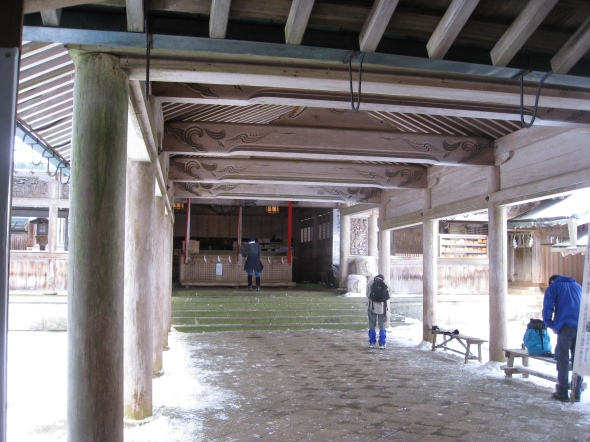
The shrine atop Atago. There was a powerful and stark simplicity to the site, built from faintly fragrant raw wood, silent in the pale light of winter.
Holy Days 1- The South Side
The days after Japanese new year’s are days for pilgrimage. A deal of businesses are closed, and people visit holy sites and relatives all over.
With a lot of retail closed, I decided to follow the traditions and headed down to Sumiyoshi Shrine on the south side of Osaka on the morning of January 1st. Osaka is not a city with too many historic sites left after the one-two punch of American carpet bombing and Japanese demolition crews, but this place is so ancient it predates the city of Osaka by more than a thousand years. It is the headquarters of a series of shrines dedicated to three gods from the Japanese creation myth, gods of seafaring and travel thought to represent stars of Orion. It survived the American air attacks during the war, the south of the city having sustained less damage than the north, so it is ancient indeed.
And it was packed. Literally as many humans as could stand and walk together had come here.
Funny thing, members of some Christian church were camped outside the gates of the shrine with banners and loudspeakers in some sort of proselytism/demonstration thing. Nobody seemed to pay them any mind.
The Way of the Philosopher
In the northeast of Kyoto is a historic site called Ginkakuji. Now a Zen temple, it was built as a retirement villa for Shogun Ashikaga Yoshimasa in the 1490s, after the fashion of a similarly famous villa/temple owned by his grandfather Ashikaga Yoshimitsu. Yoshimitsu’s pavilion was covered in gold leaf, and Ginkakuji was meant to have a similar finish in silver, but it was never completed. The permanently unfinished building has come to be a great symbol of the medieval Japanese aesthetic of imperfection, spontaneity, and weathering, and it has been long decided that the building looks best incomplete in raw wood.
I never saw it in my Kyoto days because it was undergoing a major period of upkeep and was hidden behind scaffolding and sheets. I thought it would take me many more years before I could see it…

The gardens around the pavilion provide many angles, and the building presents a different face in each one.
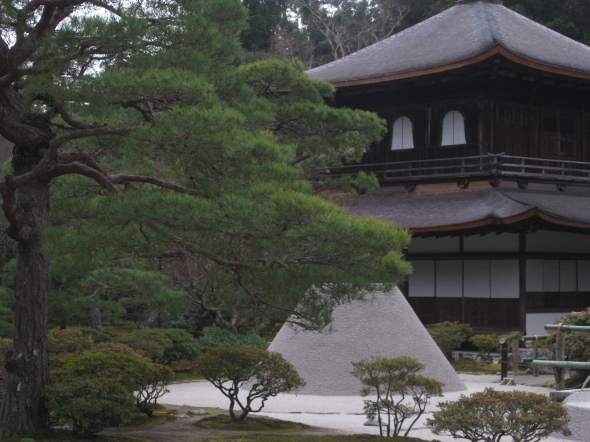
The abstracted Mt. Fuji free-formed out of sand has been considered an integral part of the temple since the 15th century.
Ginkakuji marks the northern end of a quiet lane known as the Philosopher’s Road that runs along the eastern edge of town, past many shrines, temples, and little cloisters. Exploring it was another thing I had not done in my student days.
Sojourn in Kobe
I’ve been rather preoccupied with finding work lately, so now I get a good opportunity to catch up with my posts and correspondences. On December 1st, I was still spending all my time poring through classifieds online, when I decided I really needed to get out. I had spent the previous day in my hotel room, not even leaving to get lunch. Enough of that nonsense, time to get some air. Where?, I thought. How about a city I haven’t gone to so far, and one I barely got to see during my Kyoto days? How about Kobe?
Unlike Osaka, established as one of Toyotomi Hideyoshi’s fortresses, or Kyoto, meticulously planned out to be the imperial capital, Kobe more or less grew up spontaneously as a significant port town in the age of antiquity. It was a decent sized town by the standards of the Shogun’s days, but really grew into one of Japan’s largest cities in the late 19th century after the Meiji revolution.
It’s currently the same size as Kyoto at a million and a half people, but the city has a completely different character. Kobe, unlike Kyoto, has suffered widespread damage in the last century, first as the target of intense bombing by the United States, and recently by the Hanshin Earthquake of 1995. So it’s a city with a lot of new construction, and little in the way of recognizably old sites. Because it doesn’t have Kyoto’s regulations on building height, there’s a lot more high-rise construction.
Kyoto has a downtown that is actually very dense for for a Japanese city of its size, despite its lack of skyscrapers. Comparatively, downtown Kobe feels a bit more open, with more space in between its buildings. It’s a very long and narrow urban area, tucked between the mountains and the sea, so a fresh breeze blows over the whole city.
Speaking of sea, the maritime nature of Kobe sets it apart. Osaka, just a few miles east, carries on a pretty extensive port operation of its own, but it doesn’t feel like an ocean-faring city so much as a city focused on its own sheer urbanness. Kobe, on the other hand, is a city of the sea.
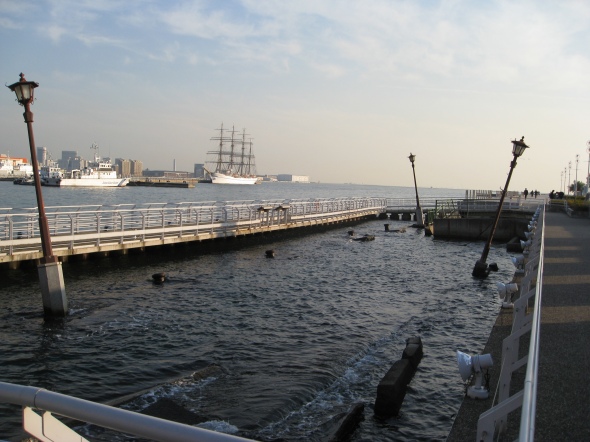
After the 1995 earthquake, the city left a small section of its seaside park unrepaired as a memorial.
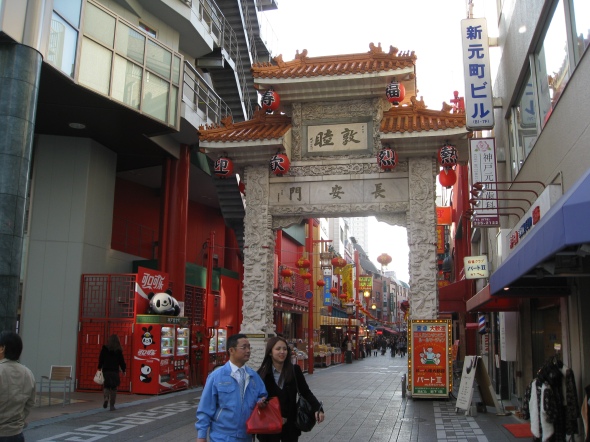
Kobe also has a chinatown. It's way smaller than I remember it from two years ago, but then again after seeing the ostensibly biggest concentrated Chinese community outside of China (Yokohama)...well, anything else looks a little limited. Still, it's always well attended.
Yokohama- Day 2
Just like old times, like old times…
In my Kyoto student days, I experienced Japan through my friends, as we wandered our way through cities and temples and railways. Me and my friend had an extra day to kill in Tokyo, so we decided to meet up and explore Yokohama. Yokohama is a port city just southwest of Tokyo, Japan’s second largest city with some 3.6 million people. It’s perhaps not as well known worldwide, or culturally influential inside Japan, as Tokyo or Osaka, because it’s actually inside Tokyo’s metro area and thus doesn’t exercise too much of its own influence. The fact that Tokyo can claim other cities of millions as satellite cities is what makes it the largest metropolitan area in the world.
It’s also a very young city by Japanese standards, not having really come into existence until the 1850s, when the Tokugawa Shogunate set it up as a free port following Commodore Perry’s incursion and forced “opening” of Japan.
My first impressions surprised me. Despite the fact that a million more people live in Yokohama than in Osaka these days, Yokohama feels like a very relaxed place. It’s not nearly as tangled or madcap as Tokyo or Osaka, broader, quieter, and greener…”high rent”, you might even say.
But we were really here for the Chinatown. Yokohama has the largest Chinese community in Japan, and apparently one of the largest outside of China. It’s dense, madly busy on a weekend, and as you might gather, full of opportunities for lunch.
It also boasts two genuine temples- one to Emperor Guan, a deification of an ancient general from the Three Kingdoms age, and one to Mazu, goddess of seafaring. The intricate decoration and well-maintained condition of the temples makes an interesting contrast to Japanese religious architecture, which tends to favor a slightly more subdued aesthetic of natural weathering.
As the shadows lengthened we said our goodbyes and set off in different directions for home. I wish we could have had more time, but we might have a chance to hang out this winter in Osaka.
As an aside, I really let this post fall by the wayside. I am, after all, here to find a job, and I’ve let that take major priority over the past few days since returning from out East.
I woke up this morning aiming to go visit Sakai, but soon discovered there seemed to be no intuitive, straightforward way to get there. So what the hell, I went back to Kyoto, this time to the east side. I sat down in my old favorite coffee shop, and could almost see and hear my old friends across the table. Wandering through Japan again is fantastic, but there was something special about being able to explore it with other people.
Because Kyoto has special regulations on building height, and the city retains its ancient grid pattern to a degree most Japanese cities don’t, the downtown streets have a strange canyon effect to them. I decided to retrace the path I took on my very first whole day in Japan so long ago, and climb the unnamed mountain behind Maruyama Park by way of Yasaka Shrine, so ancient it predates the city of Kyoto itself.
Behind Yasaka itself is Maruyama Park, apparently a bit more modern of a development from the 19th century. This was actually the first time I had passed through Maruyama in the autumn.

Downtown Kyoto from the mountaintop park. Seriously, the city looks like a matte painting. Time to bluescreen in Mark Hamill and Sir Alec.
I took a back route through the mountains to emerge literally right into the midst of Kiyomizu Temple, one of many very old and famous Buddhist sites in Kyoto. I had visited it before, but there was something about coming back…

The view from Kiyomizu. I actually found myself crying in public, standing before this scene once more.
I will be incognito for a little while now, as I’m going to Tokyo to meet some old friends, acquaintances, and mentors. More will follow, at some point.


